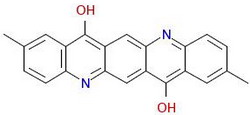Rouge pigmenté 122
| Nom du produit | PIGMENT RED 122 |
| Synonymes | C.I.Pigment Red 122; C.I.PR122; PR122; P.R.122 |
| CI | 73915 |
| N ° CAS. | 980-26-7 |
| EINECS | 213-561-3 |
| Masse moléculaire | 340.37 |
| Formule moléculaire | C22H16N2O2 |
| Densité | 1.307g/cm3 |
| Couleur | Poudre rouge |
![]()
Formule de structure moléculaire :

Fastness Properties of Pigment Red 122:
| Solidité à la lumière | 6-7 |
| Résistance à la chaleur (℃) | 180 |
| Résistance à l'eau | 5 |
| Résistance à l'huile | 5 |
| Résistance aux acides | 5 |
| Résistance aux alcalis | 5 |
| Résistance à l'alcool | 5 |
Application principale : Encre à base d'eau, Encre à base de solvant, Plastique, Peinture, Impression textile
Nous avons différentes qualités et propriétés de pigments pour répondre aux différents besoins des clients, veuillez spécifier votre application et vos exigences afin que nous puissions vous recommander en conséquence. Courriel : sy@sypigment.com
Product Description of Pigment Red 122:
The pigment variety of the quinacridone derivative has excellent migration resistance, outstanding thermal stability, and gives pure blue red or magenta. The specific surface area of Hostaprint Pink E is 62m2/g, and the specific surface area of Hostaprint Pink E Tran is 100m2/g. Mainly used for high-end automotive coatings, printing inks and plastics, and molybdenum chrome orange for outdoor coatings and powder coatings; used for PS, ABS coloring, and also used for the coloring of polypropylene and polyester puree, heat-resistant to 280℃ ; Packaging ink for high-end printing ink and laminated plastic film.
C.I. Pigment Red 122, in the form of a red powder, is a dye that can be used in printing ink applications and paint systems. This product has a specific gravity between 1.35 and 1.55, a bulk volume between 4.5 and 5.0 l/kg, and an average particle size between 50 and 150 nanometers.
TDS (Pigment Red 122) MSDS (Pigment Red 122)Synonymes
- Rouge pigmenté 122
- 980-26-7
- 2,9-Dimethylquinacridone
- C.I. Pigment Red 122
- 2,9-Dimethylquinolino[2,3-b]acridine-7,14(5H,12H)-dione
- Hostaperm Pink E
- 2,9-dimethyl-5,12-dihydroquinolino[2,3-b]acridine-7,14-dione
- UNII-28UCS3P84C
- 28UCS3P84C
- Quino[2,3-b]acridine-7,14-dione, 5,12-dihydro-2,9-dimethyl-
- MFCD00071968
- Sunfast Magenta
- Quino(2,3-b)acridine-7,14-dione, 5,12-dihydro-2,9-dimethyl-
- Permanent Pink E
- Fastogen Super Magneta R
- Hostaperm Pink EB
- Lionogen Magneta R
- Quinacridone Magneta
- PV Fast Pink E
- Monolite Rubine 3B
- Acramin Scarlet LDCN
- Hostperm Pink E 02
- Paliogen Red 4790
- Ket Red 309
- KF Red 1
- Paliogen Red L 4790
- Fastogen Super Magneta RG
- Fastogen Super Magneta RH
- Fastogen Super Magneta RS
- Quindo Magneta RV 6803
- Quindo Magneta RV 6831
- Fastogen Super Magneta RE 03
- EINECS 213-561-3
- C.I. 73915
- PigmentRed122
- 5,12-Dihydro-2,9-dimethylquino(2,3-b)acridine-7,14-dione
- 2,9-Dimethyl quinacridone
- EC 213-561-3
- SCHEMBL276094
- DTXSID2052655
- Quino(2,3-b)acridin-7,14-dione, 5,12-dihydro-2,9-dimethyl-
- ZINC5419982
- AKOS015920146
- SY030308
- CS-0010249
- A858594
- W-109625
- Q27254347
- 5,12-2H-2,9-dimethylquino[2,3-b]acridine-7,14-dione
- 2,9-Dimethylquinolino[2,3-b]-acridine-7,14(5H,12H)-dione
- 12225-00-2
Nom IUPAC : 2,9-dimethyl-5,12-dihydroquinolino[2,3-b]acridine-7,14-dione
InChI : InChI=1S/C22H16N2O2/c1-11-3-5-17-13(7-11)21(25)15-9-20-16(10-19(15)23-17)22(26)14-8-12(2)4-6-18(14)24-20/h3-10H,1-2H3,(H,23,25)(H,24,26)
InChIKey : TXWSZJSDZKWQAU-UHFFFAOYSA-N
SOURIRES canoniques : CC1=CC2=C(C=C1)NC3=CC4=C(C=C3C2=O)NC5=C(C4=O)C=C(C=C5)C
| Nom de la propriété | Valeur de la propriété |
| Masse moléculaire | 340.4 |
| XLogP3-AA | 4.8 |
| Nombre de donneurs d'obligations hydrogène | 2 |
| Nombre d'accepteurs de liaison hydrogène | 4 |
| Nombre d'obligations rotatif | 0 |
| Masse exacte | 340.1211778 |
| Masse monoisotopique | 340.1211778 |
| Surface polaire topologique | 58.2 Ų |
| Nombre d'atomes lourds | 26 |
| Charge formelle | 0 |
| Complexité | 553 |
| Nombre d'atomes isotopiques | 0 |
| Nombre défini de stéréocentres d'atomes | 0 |
| Nombre de stéréocentres d'atomes non définis | 0 |
| Nombre de stéréocentres de liaison définis | 0 |
| Nombre de stéréocentres de liaison indéfinis | 0 |
| Nombre d'unités liées par covalence | 1 |
| Le composé est canonisé | Oui |


